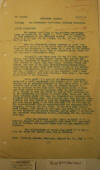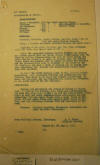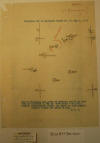|
 G-2
Report. 6,180-c. G-2
Report. 6,180-c.
NICARAGUA (Combat)
Subject: The Nicaraguan Revolution,
Military Situation.
From: Military Attaché, Nicaragua
Report No. 48
May 7, 1927
ACTIVE OPERATIONS.
All active operations of any military
importance since my report No. 46, April
13, 1927, have been covered as they
occurred in the following radios: No.
14-April. 18; Nos. 15 & 16-Apr. 20; No.
18-Apr. 30; No. 22-May 5; and No. 23-May
6.
When the Government Forces advanced on
April 12th to Moncada’s position on the
hills west of Terria Azul they found he
had abandoned it and moved to S. Jose de
les Remates and was threatening their
line of communications, which was the
Tipitapa-Teustepe-Boaco road.
Delgadillo and Reyes with 700 and 800
men, respectively, were about midway
between Tierra Azul and Muy Muy when the
direction of Moncada’s move was
discovered and they were ordered to
pursue him. Meanwhile Generals Velez and
Morago, who were in the area Trinadad La
Trinidad]-Sebaco-Ciudad Dario, were
ordered to move south with about 800 men
pm the Sebaco-Ciudad Dario-Tipitapa road
to a position between Conception and
Gen. Estrada (a town west of Los
Banderas) with a view to keeping Moncada
away from Tipitapa. This force a few
days later moved to Los Banderas.
About April 15 a part of the Government
pursuing force had a small engagement
with Moncada at S. Jose de los Remates
and he promptly withdrew to Sta. Lucia
where a light skirmish took place on the
16th and Moncada withdrew to a strong
position on two high hills five miles
north of Boaco and about midway between
Saguatepe and S. Buenaventura. He is
thought to have had about 500 men in
this position and as the Government had
forces at Tierra Azul, Boaco and Sta.
Lucia totaling about 2500 men, the
Conservatives attacked his position for
several days and reported that they had
him surrounded, but they failed to push
the fighting and Moncada slipped away
and on April 28 we find him with 1500 or
2000 men on the Conservative line of
communications and engaging them at
Bosquito, Teustepe and Sta. Cruz. In the
meantime Parajon and Sandino, with about
300 men each, had moved over from the
Western Districts and joined Moncada,
and by April 28 he had all the organized
Revolutionary Forces, including all the
generals, with him.
After the skirmish at Sta. Lucia on
April 16 or 17, General Arguello and R.
Delgadillo with about 1300 men moved
down to Teustepe and General Velez with
about 600 men occupied Los Banderas.
The distribution of troops from April 28
to May 3, when the truce was agreed
upon, was as follows:
 p.
2 p.
2
DISTRIBUTION OF TROOPS.
Conservatives.
Boaco & Boaquito: 1600 men under General
Viquez.
Teustepe: 1300 men under Gens.
Delgadillo & Arguello.
Los Banderas: 600 men under General
Velez.
Masapa: 370 men
Tipitapa: 200 men
El Paso: 100 men
Liberals.
Diamante, Boaquito, Cuesta Parada, and
Sta. Cruz: 1500 or 2000 men under
General Moncada.
(Note. A tracing is hereto attached
showing the above dist.)
Fighting at Boaquito, Teustepe and Sta.
Cruz continued until the truce was
agreed upon on May 3.
Under the agreement between General
Stimson and Moncada the latter agreed
that the United States would disarm both
the Liberals and the Conservatives and
that he would advise the other Liberal
Generals to agree to disarm; that the
Liberal forces under his command were to
remain at Boaco and Teustepe and the
Conservatives were to withdraw to the
south of the Rio Tipitapa; and that a
force of Marines was to occupy Tipitapa
separating the Liberal and Conservative
Forces until they were disarmed.
On May 6 the Fifth Marines (less 3d Bn),
Colonel Gulick commanding, was occupying
Tipitapa and patrolling the Rio Tipitapa
from there to El Paso; the Liberal
Forces were at Boaco and Teustepe; and
the Conservative Armies had withdrawn to
the south bank of the Rio Tipitapa.
CONCLUSIONS.
Moncada outmaneuvered the armies of
Viquez at Tierra Azul, S. Jose de los
Remates, Sta. Lucia and S. Buenaventura
and when the truce came on May 3 he had
the Conservative Forces split in half
and their communications interrupted and
was containing 1600 men under Viquez
with a small force at Boaquito, 600 men
under Velez with another small force at
Sta. Cruz, and was attacking Teustepe
with the remainder of his army.
 Sources.
American Legation, Nicaraguan Government
and other reliable informants. Sources.
American Legation, Nicaraguan Government
and other reliable informants.
A. W. Bloor,
Military Attaché.
p. 3
United States National Archives, College Park
MD, Record Group 165, Entry 77, Box 2660.
Transcribed by Nicholas J. Quadrini.
|

